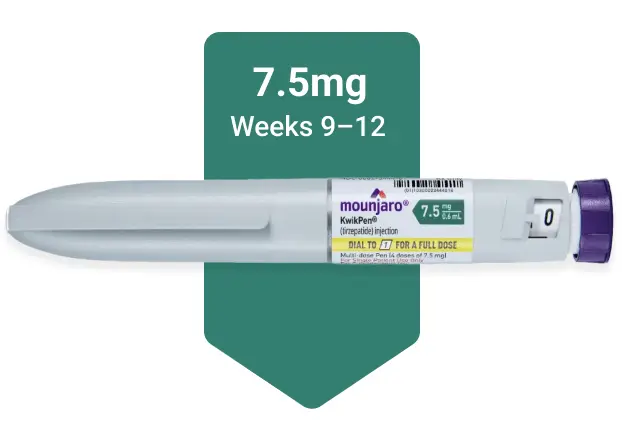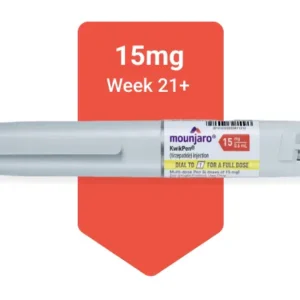Mounjaro Netherlands | Mounjaro Kopen Online
“Ontdek alles over Mounjaro Netherlands, het revolutionaire gewichtsverliesmiddel dat je helpt je doelen te bereiken. Leer hoe Mounjaro werkt, zijn voordelen en hoe het veilig kan worden gebruikt om gewicht te verliezen. Wil je Mounjaro kopen online in Nederland? Kies voor betrouwbare en gecertificeerde leveranciers die snelle levering en kwaliteit garanderen. Mounjaro ondersteunt gewichtsbeheersing door eetlust te verminderen en vetverbranding te stimuleren. Ideaal voor mensen met overgewicht of obesitas die op zoek zijn naar effectieve oplossingen. Bezoek onze website en ontdek hoe je vandaag nog veilig Mounjaro online kunt bestellen. Bereik jouw gezondheidsdoelen sneller en veiliger!”
Mounjaro (tirzepatide) is een medicijn dat wordt gebruikt om de bloedsuikerspiegel te reguleren bij volwassenen met diabetes type 2. Mounjaro wordt geleverd als een injectie die onder de huid wordt toegediend.
Dit medicijn heeft enkele beperkingen in het gebruik. Zie voor meer informatie “Waarvoor wordt Mounjaro gebruikt?” hieronder.
Mounjaro-basisprincipes
Het werkzame bestanddeel van Mounjaro is tirzepatide. (Een werkzaam bestanddeel is de stof die ervoor zorgt dat een medicijn werkt.) Uw arts of apotheker zal u laten zien hoe u uzelf thuis injecties met Mounjaro kunt toedienen.
Waarvoor wordt Mounjaro gebruikt?
Mounjaro wordt samen met lichaamsbeweging en een uitgebalanceerd dieet gebruikt om de bloedsuikerspiegel te reguleren bij volwassenen met diabetes type 2.
Diabetes type 2 is een aandoening die een hoge bloedsuikerspiegel veroorzaakt. Een hoge bloedsuikerspiegel kan na verloop van tijd het risico op andere aandoeningen verhogen, zoals een hartaanval, nierproblemen, zichtproblemen of zenuwaandoeningen. Het is belangrijk om uw bloedsuikerspiegel te reguleren om het risico op deze aandoeningen te verlagen.
Symptomen van diabetes type 2 kunnen zijn:
- dorst hebben
- vaker plassen dan gewoonlijk
- vermoeidheid (weinig energie)
- wazig zicht
- wonden die langzaam genezen
Mounjaro behandelt type 2 diabetes door uw bloedsuikerspiegel te verlagen. Dit doet het op meerdere manieren:
- door je lichaam te helpen meer insuline vrij te geven (een hormoon dat je bloedsuikerspiegel verlaagt)
- door de suikerproductie in je lever te vertragen
- door het legen van voedsel uit je maag te vertragen, waardoor je je langer vol kunt voelen
Mounjaro kent twee beperkingen in het gebruik:
- Het medicijn is niet goedgekeurd voor gebruik bij mensen met diabetes type 1.
- De behandeling met Mounjaro mag niet worden gestart bij mensen die momenteel pancreatitis hebben of die deze aandoening in het verleden hebben gehad.
Ben je op zoek naar effectieve gewichtsverliesopties in Nederland? Mounjaro biedt bewezen resultaten. Kom meer te weten over Mounjaro Netherlands, hoe het werkt en waar je Mounjaro online kunt kopen. Eenvoudig, veilig en betrouwbaar!

Wat zijn enkele veelgestelde vragen over Mounjaro?
Hier vindt u antwoorden op veelgestelde vragen over Mounjaro.
Veroorzaakt Mounjaro lichaamspijn?
Nee, Mounjaro zou geen lichaamspijnen moeten veroorzaken. Dit was geen bijwerking die werd gemeld in onderzoeken naar Mounjaro.
Maar Mounjaro kan bepaalde aandoeningen veroorzaken die rugpijn of buikpijn als symptomen hebben.
Dit medicijn kan uw risico op pancreatitis (zwelling van de alvleesklier) verhogen. Symptomen van pancreatitis kunnen rugpijn of buikpijn zijn die niet weggaat. In sommige gevallen kunt u ook last krijgen van braken.
Als u tijdens uw Mounjaro-behandeling symptomen van pancreatitis ervaart, neem dan onmiddellijk contact op met uw arts of ga naar het ziekenhuis. Dit is een ernstige bijwerking die in sommige gevallen levensbedreigend kan zijn.
Buikpijn kan ook een symptoom zijn van galblaasproblemen, wat een bijwerking is van Mounjaro. Dit is ook een ernstige aandoening die onmiddellijke behandeling vereist. Andere symptomen van galblaasproblemen zijn koorts of misselijkheid en braken.
Als u tijdens uw Mounjaro-behandeling last krijgt van lichaamspijn of pijn, neem dan direct contact op met uw arts. Hij of zij kan bepalen wat de oorzaak is van uw symptomen en wat de beste manier is om ze te behandelen. Maar als u denkt dat u een medisch noodgeval heeft, bel dan 112 of uw lokale alarmnummer.
Wil je afvallen met Mounjaro? In Nederland is Mounjaro een populaire keuze voor gewichtsverlies. Lees alles over Mounjaro Netherlands en ontdek hoe je dit product veilig online kunt kopen voor gegarandeerde resultaten!
Wordt Mounjaro gebruikt voor gewichtsverlies?
Mounjaro is niet goedgekeurd voor gebruik als afslankmiddel. Maar omdat het medicijn wordt voorgeschreven samen met lichaamsbeweging en een uitgebalanceerd dieet, kunnen sommige mensen afvallen tijdens hun Mounjaro-behandeling.
Uw arts kan Mounjaro ook off-label voorschrijven voor gewichtsbeheersing. (Off-label gebruik van een medicijn is wanneer uw arts een medicijn voorschrijft voor een ander gebruik dan waarvoor het is goedgekeurd.)
In onderzoeken meldden sommige mensen die Mounjaro gebruikten gewichtsverlies. Dit kan komen doordat het medicijn werkt om uw spijsvertering te vertragen, waardoor u zich langer vol kunt voelen. Bovendien kan dit medicijn misselijkheid of verminderde eetlust veroorzaken, wat kan leiden tot gewichtsverlies.
Als u vragen heeft over gewichtsverlies met Mounjaro, neem dan contact met ons op of praat met uw arts.
Wat zijn de bijwerkingen van Mounjaro?
Zoals de meeste medicijnen kan Mounjaro milde of ernstige bijwerkingen veroorzaken. De onderstaande lijsten beschrijven enkele van de meest voorkomende bijwerkingen die Mounjaro kan veroorzaken. Deze lijsten bevatten niet alle mogelijke bijwerkingen.
Houd er rekening mee dat de bijwerkingen van een medicijn kunnen afhangen van:
- andere gezondheidsproblemen die u heeft
- andere medicijnen die u neemt
Uw arts of apotheker kan u meer vertellen over de mogelijke bijwerkingen van Mounjaro. Ze kunnen ook suggesties doen om bijwerkingen te verminderen.
Lichte bijwerkingen
Hier is een lijst met enkele milde bijwerkingen die Mounjaro kan veroorzaken. Om meer te weten te komen over andere milde bijwerkingen, praat met uw arts of apotheker, of lees de voorschrijfinformatie van Mounjaro.
Milde bijwerkingen van Mounjaro die zijn gemeld, zijn onder meer:
- misselijkheid en braken
- diarree
- verminderde eetlust
- constipatie
- buikpijn
- reacties op de injectieplaats
- brandend maagzuur
- milde allergische reactie*
Milde bijwerkingen van veel medicijnen kunnen binnen een paar dagen tot een paar weken verdwijnen. Maar als ze hinderlijk worden, praat dan met uw arts of apotheker.
Start je reis naar gewichtsverlies met Mounjaro in Nederland. Ontdek de voordelen van dit revolutionaire middel en leer hoe je Mounjaro kopen online kunt regelen. Maak de beste keuze voor jouw gezondheid vandaag nog!
Ernstige bijwerkingen
Ernstige bijwerkingen van Mounjaro kunnen optreden, maar ze komen niet vaak voor. Als u ernstige bijwerkingen van Mounjaro ervaart, bel dan onmiddellijk uw arts. Maar als u denkt dat u een medisch noodgeval heeft, bel dan onmiddellijk 112 of uw lokale alarmnummer.
Ernstige bijwerkingen van Mounjaro die zijn gemeld, zijn onder andere:
- pancreatitis (zwelling van de alvleesklier)
- galblaasproblemen
- hypoglykemie (lage bloedsuikerspiegel)
- ernstige spijsverteringsbijwerkingen, zoals ernstige misselijkheid, braken of diarree, wat kan leiden tot uitdroging en nierproblemen
- omkaderde waarschuwing: risico op schildklierkanker*
- ernstige allergische reactie†
ALLERGISCHE REACTIE
Sommige mensen kunnen allergisch reageren op Mounjaro.
Symptomen van een milde allergische reactie kunnen zijn:
- huiduitslag
- jeuk
- blozen (tijdelijke warmte, roodheid of verdieping van de huidskleur)
Een ernstigere allergische reactie is zeldzaam maar mogelijk.
Symptomen van een ernstige allergische reactie kunnen zijn:
- zwelling onder uw huid (meestal in uw oogleden, lippen, handen of voeten)
- zwelling van uw tong, mond of keel, wat ademhalingsproblemen kan veroorzaken
Bel direct uw arts als u allergisch reageert op Mounjaro. Maar als u denkt dat u een medisch noodgeval heeft, bel dan uw lokale alarmnummer.

Wat is de dosering van Mounjaro?
Uw arts zal de dosering van Mounjaro aanbevelen die voor u geschikt is. Hieronder staan de meest gebruikte doseringen, maar gebruik altijd de dosering die uw arts voorschrijft.
Formulier
Mounjaro wordt geleverd als een vloeibare oplossing die als injectie onder de huid wordt toegediend.
Aanbevolen doseringen
U injecteert Mounjaro eenmaal per week. Uw arts zal u waarschijnlijk laten beginnen met een lage dosis Mounjaro. Daarna verhogen ze uw dosis na 4 weken behandeling. Beginnen met een lagere dosis helpt uw lichaam om te wennen aan de medicatie.
Als uw huidige dosis Mounjaro uw bloedsuikerspiegel niet goed genoeg onder controle houdt, kan uw arts uw dosis nog verder verhogen. Dit zal na nog eens 4 weken gebeuren, indien nodig.
Vragen over de dosering van Mounjaro
Hieronder staan enkele veelgestelde vragen over de dosering van Mounjaro.
- Wat als ik een dosis Mounjaro mis? Als u uw dosis Mounjaro mist, neem deze dan zo snel mogelijk in, zolang het binnen 4 dagen is nadat de dosis had moeten worden ingenomen. Ga dan verder met uw normale doseringsschema. Maar als er meer dan 4 dagen zijn verstreken sinds u uw dosis bent vergeten, sla dan uw gemiste dosis over en neem uw volgende dosis op de gebruikelijke dag. Ga dan verder met uw normale doseringsschema.
- Moet ik Mounjaro langdurig gebruiken? Ja, u zult Mounjaro waarschijnlijk langdurig gebruiken. Dit medicijn helpt bij het beheersen van diabetes type 2, wat een chronische aandoening is. Dus als Mounjaro voor u werkt, zal uw arts u waarschijnlijk aanraden het langdurig te gebruiken.
- Hoe lang duurt het voordat Mounjaro werkt? Mounjaro begint te werken direct nadat u uw eerste dosis hebt geïnjecteerd, maar het kan enige tijd duren voordat u een verandering in uw bloedsuikerspiegel ziet. Sommige mensen beginnen binnen een paar weken na het starten van de behandeling een effect te zien. Als u vragen heeft over wanneer u resultaten van Mounjaro kunt verwachten, bespreek dit dan met uw arts.
Mounjaro Netherlands biedt een innovatieve oplossing voor gewichtsverlies. Lees alles over de werking en waar je Mounjaro online kunt kopen. Kies voor gemak, veiligheid en gegarandeerde resultaten bij jouw vertrouwde online winkel.
Hoe wordt Mounjaro gebruikt?
Uw arts zal uitleggen hoe u Mounjaro moet gebruiken. Hij zal ook uitleggen hoeveel u moet gebruiken en hoe vaak. Zorg ervoor dat u de instructies van uw arts opvolgt.
Mounjaro gebruiken
Mounjaro wordt geleverd als een vloeibare oplossing in een voorgevulde pen voor eenmalig gebruik. U injecteert Mounjaro eenmaal per week onder uw huid. U kunt uw dosis met of zonder voedsel innemen.
Mounjaro kan in uw buik, dij of bovenarm worden geïnjecteerd. (Als u het medicijn in uw bovenarm wilt injecteren, hebt u waarschijnlijk iemand nodig die u helpt.) U moet de plekken waar u het medicijn injecteert afwisselen om huidirritatie op de injectieplaats te voorkomen.
Voordat u met uw Mounjaro-behandeling begint, kan uw arts of apotheker u laten zien hoe u het medicijn injecteert. Voor stapsgewijze instructies of een video over het gebruik van Mounjaro, zie de website van de fabrikant.
Het is belangrijk om op te merken dat als u insuline samen met Mounjaro gebruikt, u uw doses in hetzelfde gebied van uw lichaam kunt injecteren, zoals uw dij. Probeer echter verschillende injectieplaatsen te gebruiken die een paar centimeter uit elkaar liggen om reacties op de injectieplaats, zoals pijn of irritatie, te voorkomen. Ook mag u nooit insuline met Mounjaro in dezelfde spuit mengen.
Als u vragen hebt over de toediening van Mounjaro, neem dan contact op met uw arts of apotheker.
Toegankelijke medicijncontainers en etiketten
Als het voor u moeilijk is om het etiket op uw recept te lezen, vertel het dan aan uw arts of apotheker. Bepaalde apotheken kunnen medicijnetiketten verstrekken die:
- hebben grote letters
- gebruik braille
- bevatten een code die u met een smartphone kunt scannen om de tekst in audio te veranderen
Uw arts of apotheker kan u mogelijk een apotheek aanbevelen die deze opties aanbiedt, als uw huidige apotheek dat niet doet.
Mounjaro gebruiken met andere medicijnen
Uw arts kan naast Mounjaro andere medicijnen voorschrijven om uw bloedsuikerspiegel te reguleren. Voorbeelden van deze medicijnen zijn:
- metformine (Fortamet, Glumetza)
- insuline, zoals:
- insuline lispro (Admelog, Humalog, Lyumjev)
- insuline glargine (Lantus, Basaglar, Toujeo)
- glimepiride (Amaryl)
- rosiglitazon (Avandia)
- linagliptine (Tradjenta)
- canagliflozine (Invokana)
Het is belangrijk om op te merken dat het gebruik van Mounjaro met andere diabetesbehandelingen, met name insuline, uw risico op hypoglykemie (lage bloedsuikerspiegel) kan verhogen. Dit kan ernstig of zelfs levensbedreigend zijn als het niet snel wordt behandeld. Daarom kan uw arts uw bloedsuikerspiegel vaker controleren als u Mounjaro met andere behandelingen gebruikt. In sommige gevallen kan uw arts de dosering van uw andere diabetesmedicijnen verlagen om een lage bloedsuikerspiegel te helpen voorkomen.
Vragen over het innemen van Mounjaro
Hieronder vindt u enkele veelgestelde vragen over het gebruik van Mounjaro.
- Moet ik Mounjaro met voedsel innemen? U kunt uw dosis Mounjaro met of zonder voedsel innemen.
- Is er een beste tijd van de dag om Mounjaro in te nemen? Nee. U injecteert Mounjaro eenmaal per week en kunt dit doen op elk tijdstip van de dag dat voor u het beste werkt. Zorg er alleen voor dat u Mounjaro elke week op dezelfde dag injecteert.
Waar moet ik op letten voordat ik Mounjaro gebruik?
Enkele belangrijke zaken die u met uw arts moet bespreken wanneer u een behandeling met Mounjaro overweegt, zijn onder meer:
- uw algemene gezondheid
- eventuele medische aandoeningen die u heeft.
Vertel uw arts ook of u medicijnen gebruikt. Dit is belangrijk omdat bepaalde medicijnen Mounjaro kunnen verstoren.
Deze en andere overwegingen om met uw arts te bespreken, worden hieronder beschreven.
Interacties
Het innemen van medicijnen, vaccins, voedsel en andere dingen met een bepaald medicijn kan de werking van het medicijn beïnvloeden. Deze effecten worden interacties genoemd.
Voordat u Mounjaro gebruikt, moet u uw arts vertellen over alle medicijnen die u gebruikt (inclusief voorgeschreven en vrij verkrijgbare soorten). Beschrijf ook alle vitamines, kruiden of supplementen die u gebruikt. Uw arts of apotheker kan u vertellen over eventuele interacties die deze items kunnen veroorzaken met Mounjaro.
Interacties met medicijnen of supplementen
Mounjaro kan interacteren met verschillende soorten drugs. Deze drugs omvatten:
- insulines, zoals:
- insuline glargine (Lantus, Basaglar, Toujeo)
- insuline lispro (Admelog, Humalog, Lyumjev)
- sulfonylureumderivaten, zoals:
- glipizide (Glucotrol XL)
- glyburide (Diabeta, Glynase)
- glimepiride (Amaryl)
- warfarine (Jantoven)
- anticonceptiepillen zoals ethinylestradiol/norethindron (Junel)
Deze lijst bevat niet alle soorten medicijnen die kunnen interacteren met Mounjaro. Uw arts of apotheker kan u meer vertellen over deze interacties en andere die kunnen optreden met Mounjaro.
Ingekaderde waarschuwing
Mounjaro heeft een omkaderde waarschuwingTrusted Source. Dit is de ernstigste waarschuwing van de Food and Drug Administration (FDA). Het waarschuwt artsen en patiënten voor mogelijke gevaarlijke bijwerkingen van medicijnen.
Risico op schildklierkanker. Het gebruik van Mounjaro kan het risico op het ontwikkelen van schildklierkanker verhogen. In onderzoeken hadden dieren die Mounjaro kregen een verhoogd risico op schildklierkanker. Maar het is niet bekend of Mounjaro schildklierkanker, met name medullaire schildklierkanker (MTC), bij mensen kan veroorzaken.
Als u of een familielid een voorgeschiedenis van MTC heeft of als u het multipele endocriene neoplasiesyndroom type 2 (MEN 2) heeft gehad, vertel dit dan aan uw arts voordat u Mounjaro gebruikt. Vanwege de bijbehorende risico’s zullen zij u waarschijnlijk een andere behandelingsoptie aanbevelen.
Tijdens uw Mounjaro-behandeling moet u letten op symptomen van schildklierkanker. Deze symptomen kunnen zijn:
- een knobbel of zwelling in uw nek
- moeite met slikken
- moeite met ademhalen
- heesheid
Uw arts kan u ook aanraden om bepaalde bloedtesten of echo’s te laten doen om uw schildklier te controleren tijdens uw behandeling.
Als u vragen hebt over het risico op schildklierkanker met Mounjaro, praat dan met uw arts of apotheker.
Andere waarschuwingen
Mounjaro is mogelijk niet geschikt voor u als u bepaalde medische aandoeningen heeft. Deze staan bekend als interacties tussen geneesmiddelen en aandoeningen. Andere factoren kunnen ook van invloed zijn op de vraag of Mounjaro een goede behandelingsoptie voor u is.
Praat met uw arts over uw medische voorgeschiedenis voordat u Mounjaro gebruikt. Factoren om te overwegen zijn onder andere de onderstaande.
Pancreatită. Mounjaro kan pancreatitis veroorzaken. Als u deze aandoening eerder heeft gehad, is uw risico op het ontwikkelen van pancreatitis met Mounjaro mogelijk hoger. Praat met uw arts over de vraag of Mounjaro veilig voor u is voordat u Mounjaro gebruikt.
Nierproblemen. Mounjaro kan spijsverteringsproblemen veroorzaken die leiden tot uitdroging en nierproblemen. Als u al nierproblemen heeft, kan het gebruik van Mounjaro uw aandoening verergeren. Praat met uw arts voordat u dit medicijn gebruikt. Als zij Mounjaro voorschrijven, kan uw arts uw nieren nauwlettend in de gaten houden tijdens uw behandeling.
Diabetische retinopathie. Als u een zichtprobleem heeft dat diabetische retinopathie wordt genoemd, kan het gebruik van Mounjaro dit verergeren. Als u deze aandoening heeft, praat dan met uw arts voordat u met uw Mounjaro-behandeling begint. Uw arts kan uw zicht tijdens uw behandeling nauwlettender in de gaten houden.
Ernstige spijsverteringsproblemen. Vertel uw arts voordat u met de behandeling met Mounjaro begint of u ernstige spijsverteringsproblemen heeft, zoals gastroparese. Mounjaro is niet onderzocht bij mensen met ernstige spijsverteringsproblemen, dus uw arts zal u waarschijnlijk een andere behandelingsoptie aanbevelen.
Allergische reactie. Als u een allergische reactie heeft gehad op Mounjaro of een van de ingrediënten, zal uw arts u Mounjaro waarschijnlijk niet voorschrijven. Vraag hen naar andere medicijnen die betere opties kunnen zijn.
Mounjaro en alcohol
Het zou veilig moeten zijn om alcohol te drinken tijdens uw Mounjaro-behandeling. Maar het combineren van Mounjaro met alcohol kan het risico op bepaalde bijwerkingen van het medicijn vergroten of ze verergeren.
Alcohol drinken kan ook hypoglykemie (lage bloedsuikerspiegel) veroorzaken bij mensen met diabetes. Dit kan ernstig worden als het niet snel wordt behandeld.
Als u alcohol drinkt, bespreek dan met uw arts hoeveel u veilig kunt drinken met uw aandoening en behandelplan.
Zwangerschap en borstvoeding
onze arts zal waarschijnlijk aanraden dat u Mounjaro niet gebruikt tijdens de zwangerschap. Het is mogelijk dat Mounjaro schadelijk kan zijn voor een foetus.
Het is belangrijk om op te merken dat onbehandelde diabetes tijdens de zwangerschap problemen kan veroorzaken met de ontwikkeling van de foetus (algemeen bekend als geboorteafwijkingen) of zwangerschapsverlies. Als u zwanger bent of van plan bent om zwanger te worden, bespreek dan met uw arts wat de beste behandelingsoptie is voor uw aandoening.
Uw arts zal waarschijnlijk ook aanraden dat u Mounjaro niet gebruikt tijdens het geven van borstvoeding. Het is niet bekend of het medicijn in de moedermelk terecht kan komen of welke effecten het kan hebben op een kind dat borstvoeding krijgt. Als u borstvoeding geeft of van plan bent om borstvoeding te geven, bespreek dit dan met uw arts voordat u Mounjaro gebruikt.
Wat moet je doen bij een overdosis?
Injecteer niet meer Mounjaro dan uw arts heeft voorgeschreven, omdat dit ernstige bijwerkingen kan veroorzaken.
Wat te doen als u te veel Mounjaro gebruikt
Neem contact met ons op via e-mail of bel uw arts als u denkt dat u te veel Mounjaro heeft geïnjecteerd. Maar als u ernstige symptomen heeft, bel dan onmiddellijk uw lokale alarmnummer. Of ga naar de dichtstbijzijnde spoedeisende hulp.





Recenzii
Nu există recenzii până acum.